Crusty on the outside, and soft and tender inside, this easy gluten-free baguette recipe is perfect for making sandwiches for lunch or dinner, or slicing and toasting to make garlic bread or bruschetta for an appetizer or snack. No kneading required, this recipe is also dairy-free. Bake a batch and enjoy homemade baguettes today!
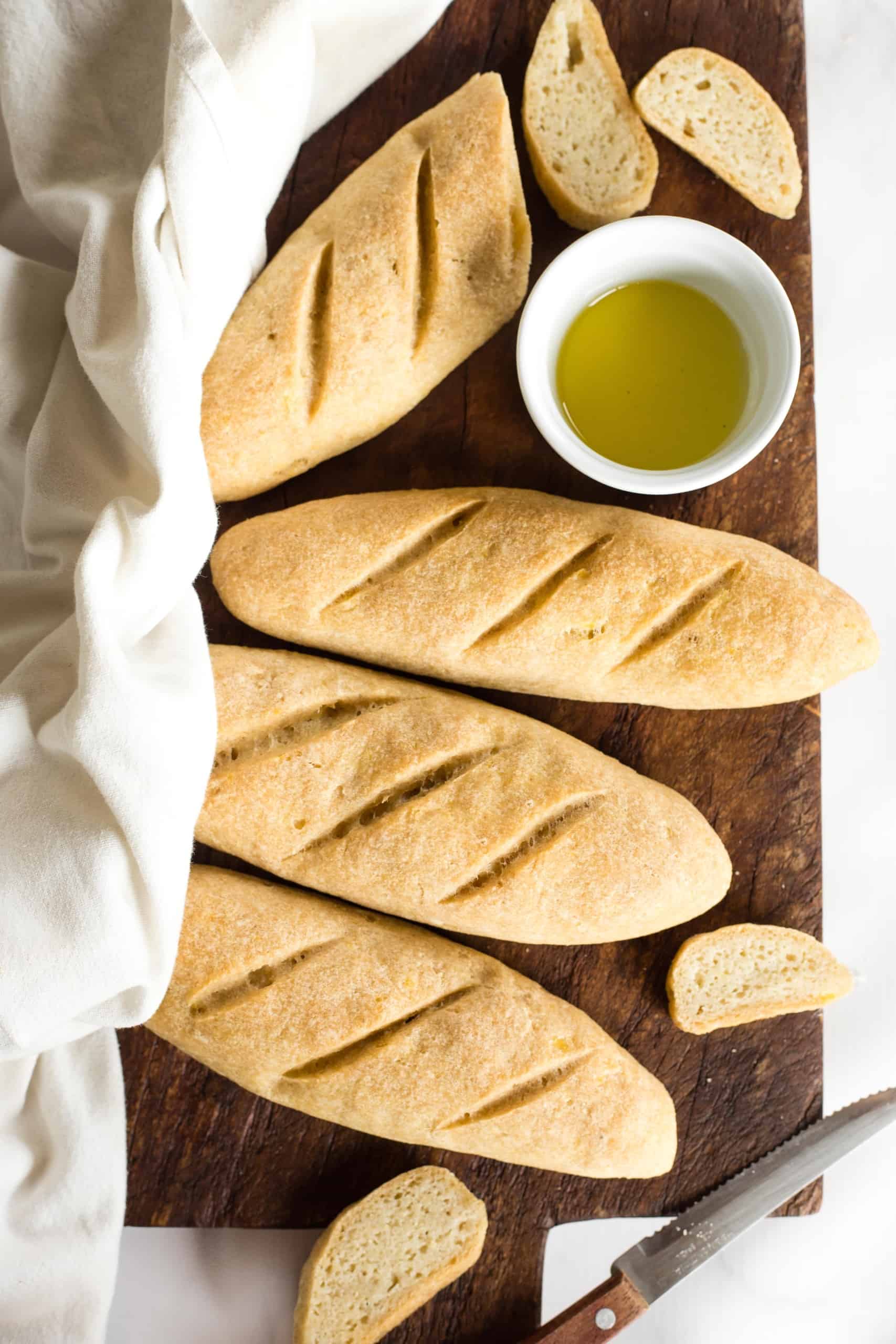
Want to save this recipe?
Enter your email & I’ll send it to your inbox. Plus, get great new recipes from me every week!
Jump to:
- Homemade Bread is the Best
- Our Favorite Gluten-Free Bread Recipes
- Amazing Gluten-Free Baguette
- Why This Recipe Works
- Ingredients You’ll Need:
- Recipe Notes + Substitutions:
- How to Make this Gluten-Free Baguette Recipe (Step by Step)
- Dish by Dish Tips/Tricks:
- Recipe FAQs:
- What to Serve with This Gluten-Free Baguette
- Other Gluten-Free Breads You’ll Love:
- Gluten-Free Appetizers to Serve:
- Gluten-Free Baguette Recipe (Dairy-Free)
Homemade Bread is the Best
Once you’ve started your journey on baking homemade bread, it’s hard to go back.
For me, baking bread is a therapy and there’s really nothing more gratifying than seeing your own home baked bread loaves on the table, made from scratch with your own hands.
Watching bread dough rise as the yeast works its magic and seeing it transform into fresh bread is just one of those things that brings joy to my day in the most amazing way.
Our Favorite Gluten-Free Bread Recipes
Some of our favorite gluten-free yeast breads include:
- Soft, Fluffy Gluten-Free Bread (Dairy-Free)
- Buckwheat Bread (Gluten-Free, Dairy-Free)
- Brown Rice Bread (Gluten-Free, Dairy-Free)
- Sorghum Bread (Gluten-Free, Dairy-Free)
- Millet Bread (Gluten-Free, Dairy-Free)
- Quinoa Bread (Gluten-Free, Dairy-Free)
- Pumpkin Yeast Bread (Gluten-Free, Dairy-Free)
- Artisan No-Knead Bread (Gluten-Free, Dairy-Free)
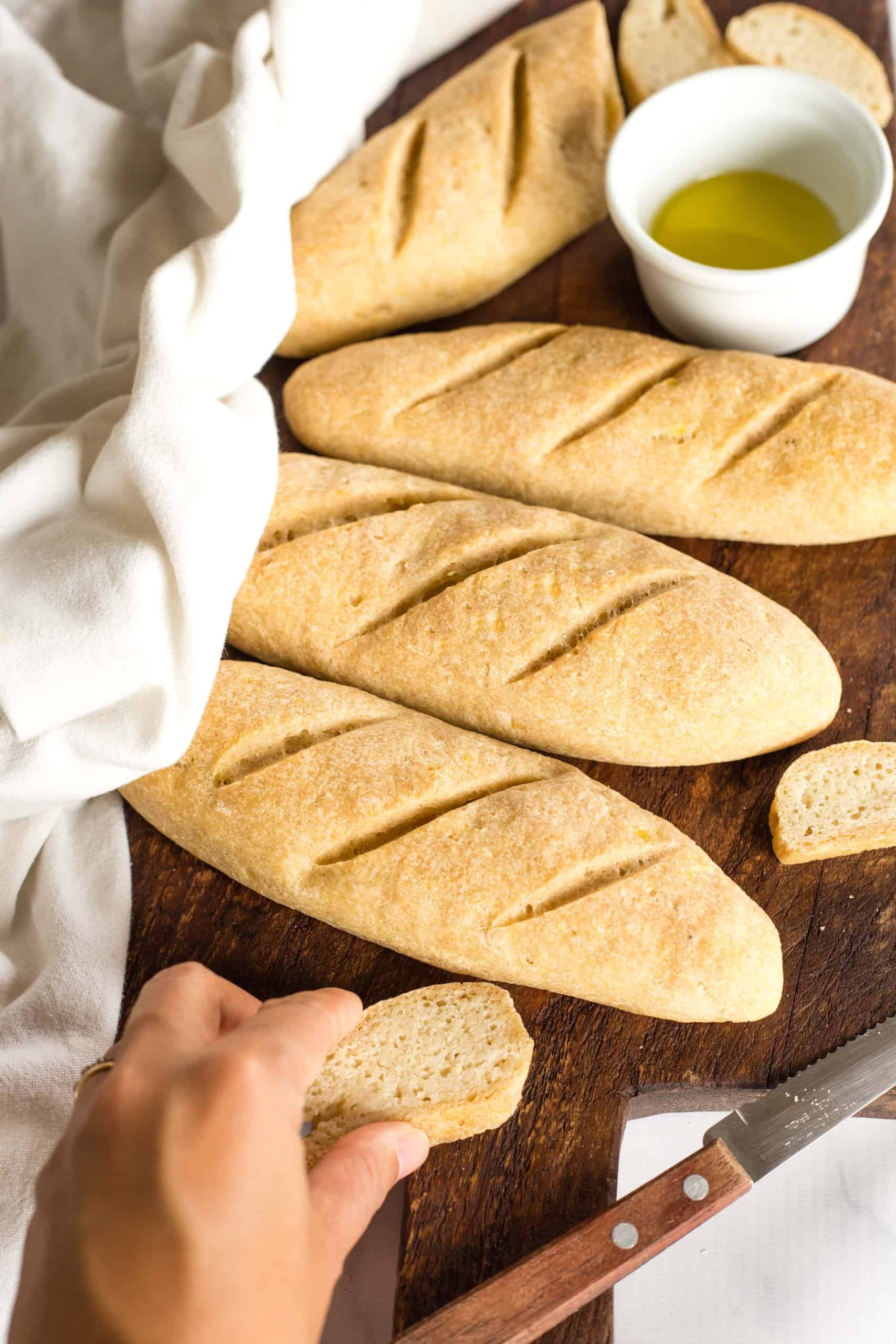
Amazing Gluten-Free Baguette
Baguettes, if you aren’t familiar with them, are basically French bread that are recognized for their shape – they are often long in shape (sometimes even up to 1 meter long!) with a diameter or approximately 2 to 2 1/2 inches.
I often think of French women with a baguette under their arm (or at least that’s the stereotype that comes to my mind).
I’ve been working on a recipe for gluten-free French baguettes for the longest time, and after testing out and trying quite a few (failed!) recipes, I’ve finally developed a gluten-free version using the dough from my gluten-free potato bread recipe!
The trick in getting a moist tender texture is in the mashed potatoes. Yep, you heard me right!
Why This Recipe Works
- Simple Ingredients: The ingredients required for this gluten-free baguette recipe are easily accessible at the local grocery store (nothing fancy required!)
- Easy to Make: Even if it’s your first time making baguettes, don’t worry! All you need to do is to mix the wet ingredients with the dry ingredients to form the dough, which you then shape into baguettes before letting the dough rise and then baking! Plus, did I mention that no kneading is required to make this delicious bread?
- Amazing Texture: It’s soft, tender and moist on the inside and golden and crusty outside, these chewy baguettes are must have in your baking repertoire!
- Totally Gluten-Free and Dairy-Free: The best part is that this easy baguette recipe is 100% gluten-free and dairy-free, which means that even those with Celiac disease or gluten or lactose intolerances can still enjoy it without worries!
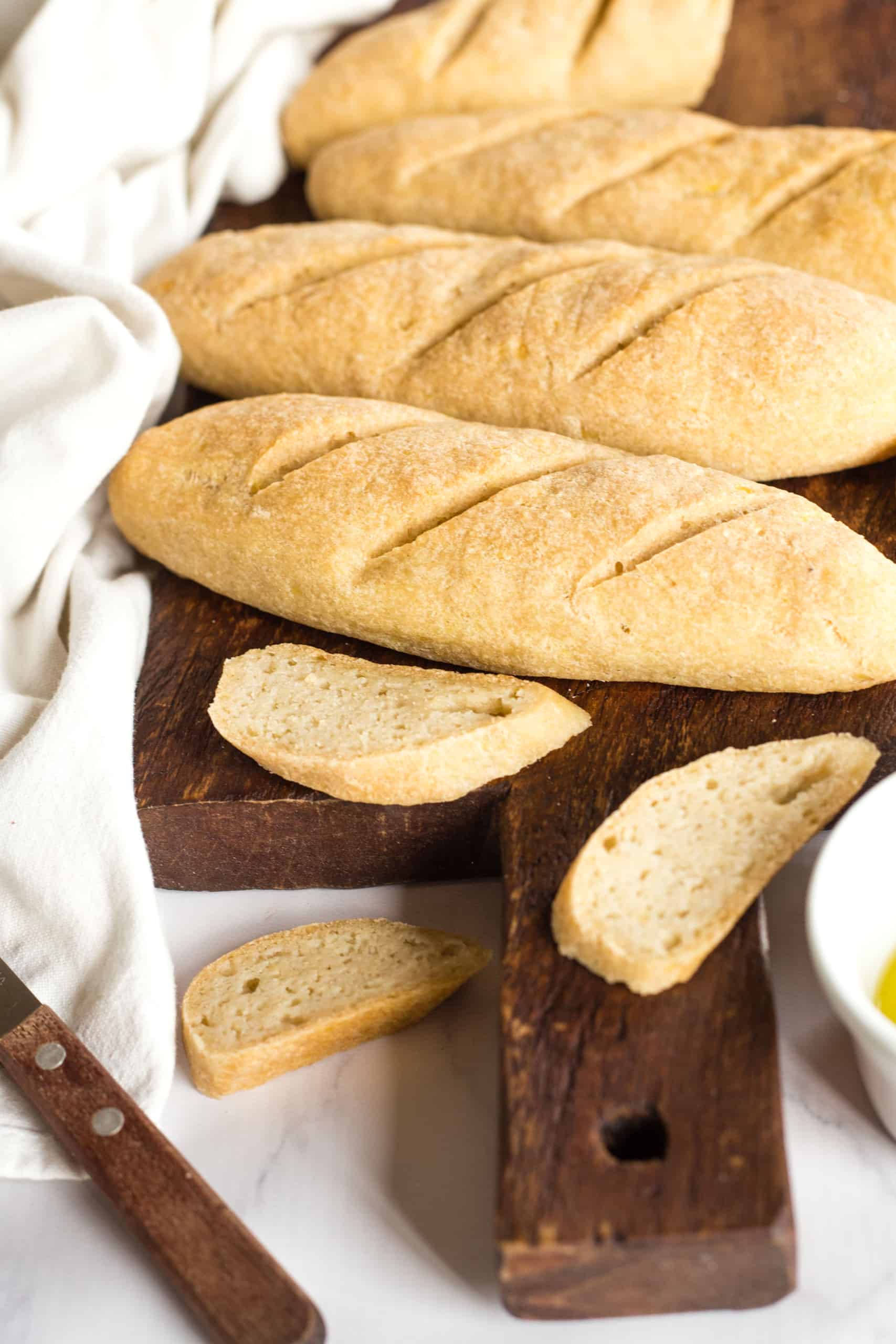
Ingredients You’ll Need:
Here’s a visual overview of the ingredients required for this gluten-free baguette recipe.
(For exact measurements and quantities, please scroll down to the recipe card at the bottom of this post.)
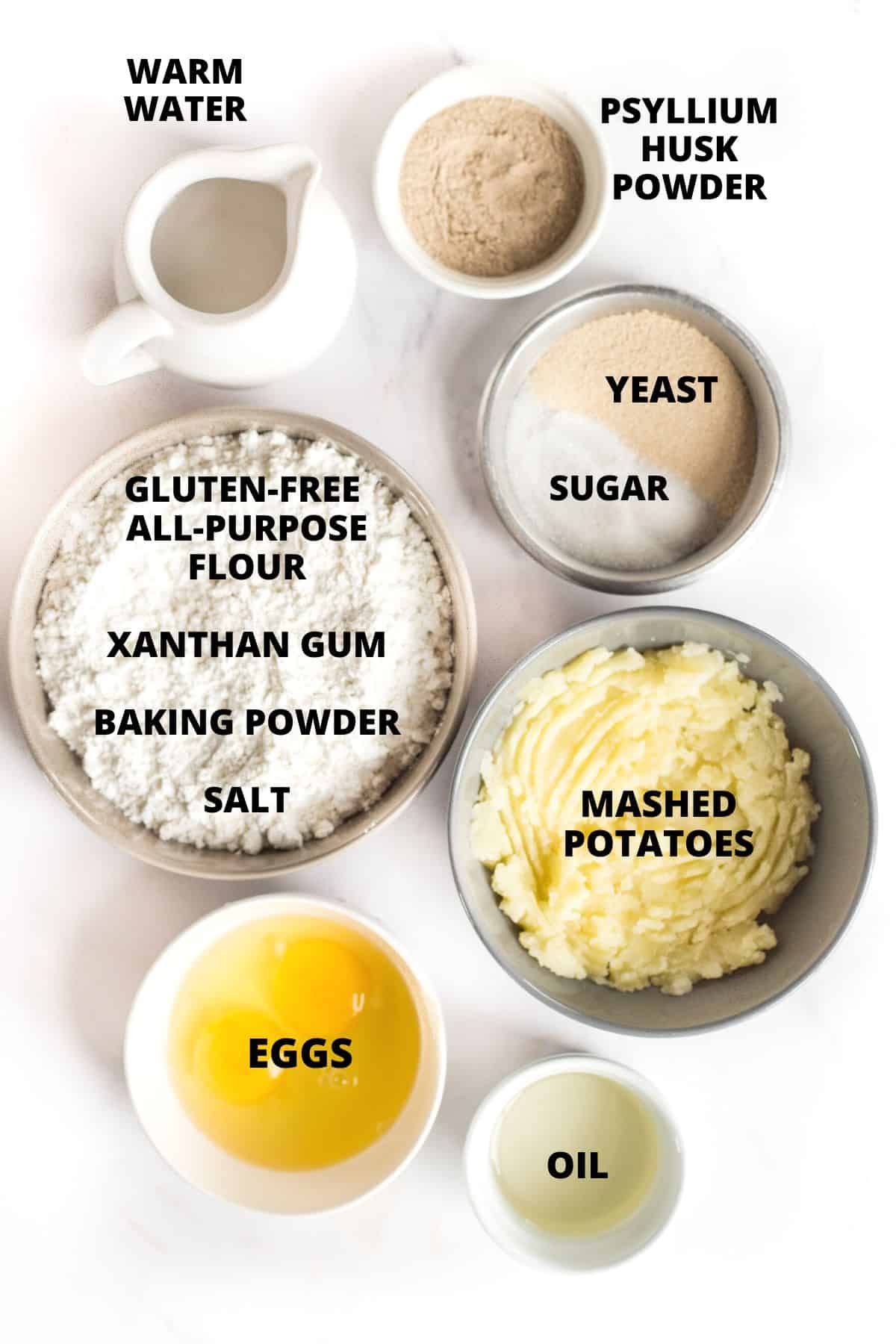
Recipe Notes + Substitutions:
- Mashed Potatoes: For best results, I recommend using fresh mashed potatoes (made from potatoes instead of the mashed potato powder). You can make mashed potatoes by boiling sliced potatoes in water until fork-tender and then mashing the boiled potatoes until they are soft.
- Eggs: Eggs help to bind the ingredients better and gives the dough better rise. If you prefer not to use egg yolks, you can replace the two eggs with four egg whites instead. I personally have not made this recipe without eggs, but if you are allergic to eggs, I believe you should be able to replace the eggs with acquafaba or an egg-replacer. (If you do make this gluten-free baguette recipe egg-free, please let me know how it goes in the comments below, I’d love to know!)
- Warm Water: Make sure that the water is between 105F to 115F as the warmth is required to activate the yeast, but if the water is too hot, the hight temperature will kill the yeast. You may also use warm unsweetened non-dairy milk instead of water (such as almond milk, cashew milk, rice milk, soy milk or oat milk). Alternatively, if you are not lactose-intolerant, feel free to use normal milk instead.
- Sunflower Oil: I like using sunflower oil because I always have a bottle of it on hand. You may also use melted vegan butter or another vegetable oil (such as olive oil, avocado oil, or melted coconut oil). Alternatively, if you are not lactose-intolerant, fee free to use melted butter or ghee instead.
- Gluten-Free All-Purpose Flour: I recommend using a good-quality gluten-free all-purpose flour blend that is made up of lighter flours/starches (such as rice flour, tapioca starch, corn starch or potato starch) for a lighter and fluffier final texture. I do NOT recommend using a gluten-free flour blend that includes heavier flours (such as garbanzo bean flour) as that will result in a denser texture.
- Xanthan Gum: Xanthan gum is the replacement for gluten in gluten-free flours, so make sure to include it if your gluten-free flour blend does not already have it.
- Baking Powder: In addition to the yeast, baking powder gives the dough a little more rise. If you are Celiac or gluten-intolerant, make sure to use certified gluten-free baking powder.
- Psyllium Husk Powder: I personally find that the addition of psyllium husk powder makes a big difference in how gluten-free yeast breads turn out, as it adds structure and binding power to the ingredients. Make sure you use the powder version. If you only have access to whole psyllium husks, simply grind the whole psyllium seed husks in a coffee grinder or high-speed blender until you get a very fine powder.
- Instant Yeast: I like using instant yeast because there is no prior activation required and you can mix the instant yeast together with the other dry ingredients. If you only have active yeast, make sure to activate the yeast before mixing it with the other ingredients. (To activate, combine the yeast, warm water and sugar in a small bowl and mix well. Let the mixture sit for 5 minutes in a warm place until foamy before adding to other ingredients.)
- Sugar: The sugar is “food” for the yeast to feed on in order to be activated and produce the gases required to create the air bubbles for the dough to rise. I used white sugar, but you can also use light brown sugar, dark brown sugar or coconut sugar.
How to Make this Gluten-Free Baguette Recipe (Step by Step)
1. Line
Line a large baking sheet with parchment paper or a silpat.
2. Blend Potatoes and Eggs
Combine mashed potatoes and eggs in the bowl of a blender and blend until you get a smooth pale yellow mixture.
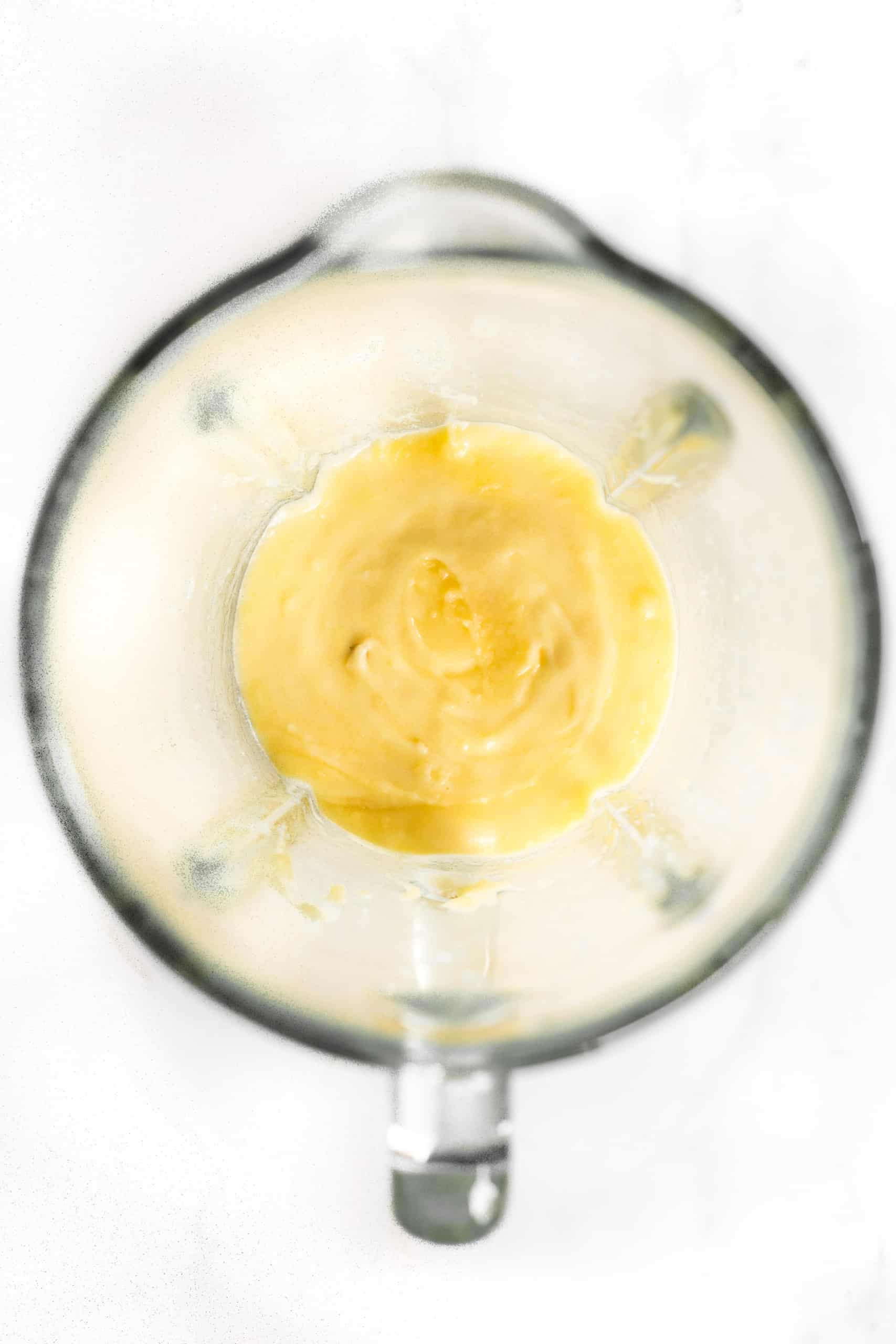
3. Add Oil and Water
Transfer the blended potato-egg mixture to a large mixing bowl. Add warm water and oil and mix until you get a homogeneous liquid mixture.
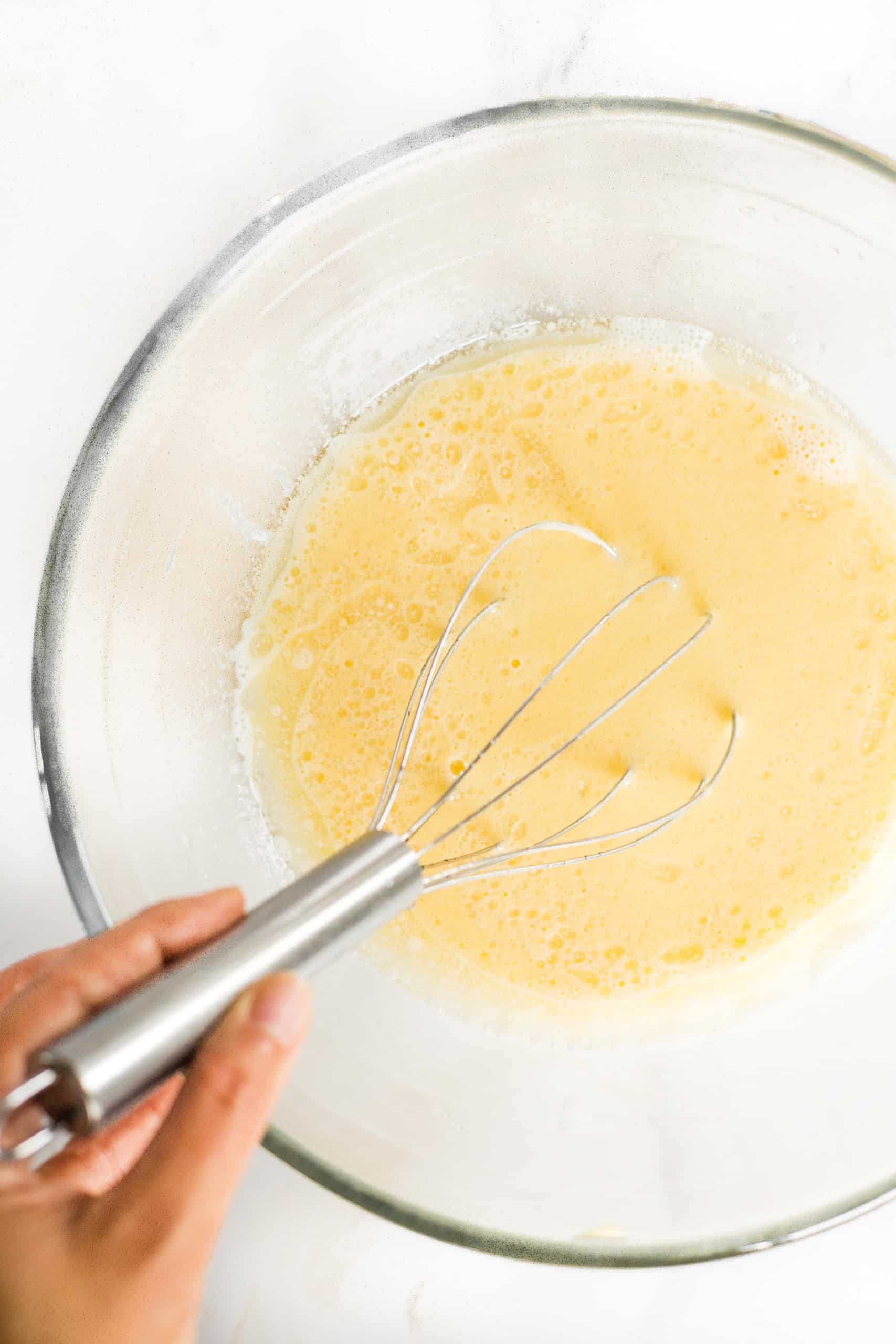
4. Whisk Dry Ingredients
In another bowl, sift the gluten-free flour, xanthan gum (if using), baking powder, salt, psyllium husk powder, instant yeast, and sugar. Whisk well to combine.
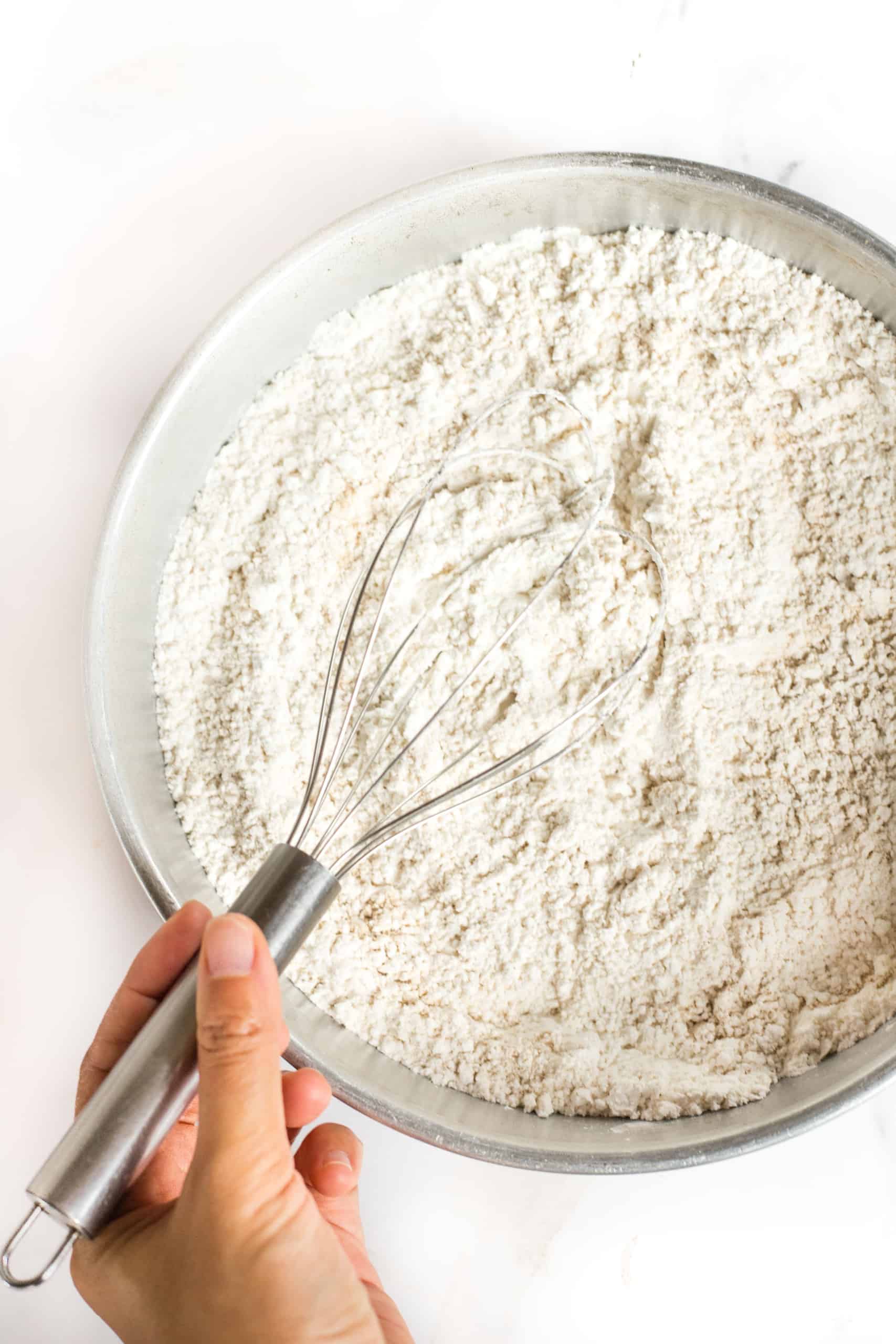
5. Form Dough
Add the dry ingredients to the large bowl with the wet ingredients and mix well until you get a wet and sticky dough (the dough will resemble cake batter and that’s the texture you want).
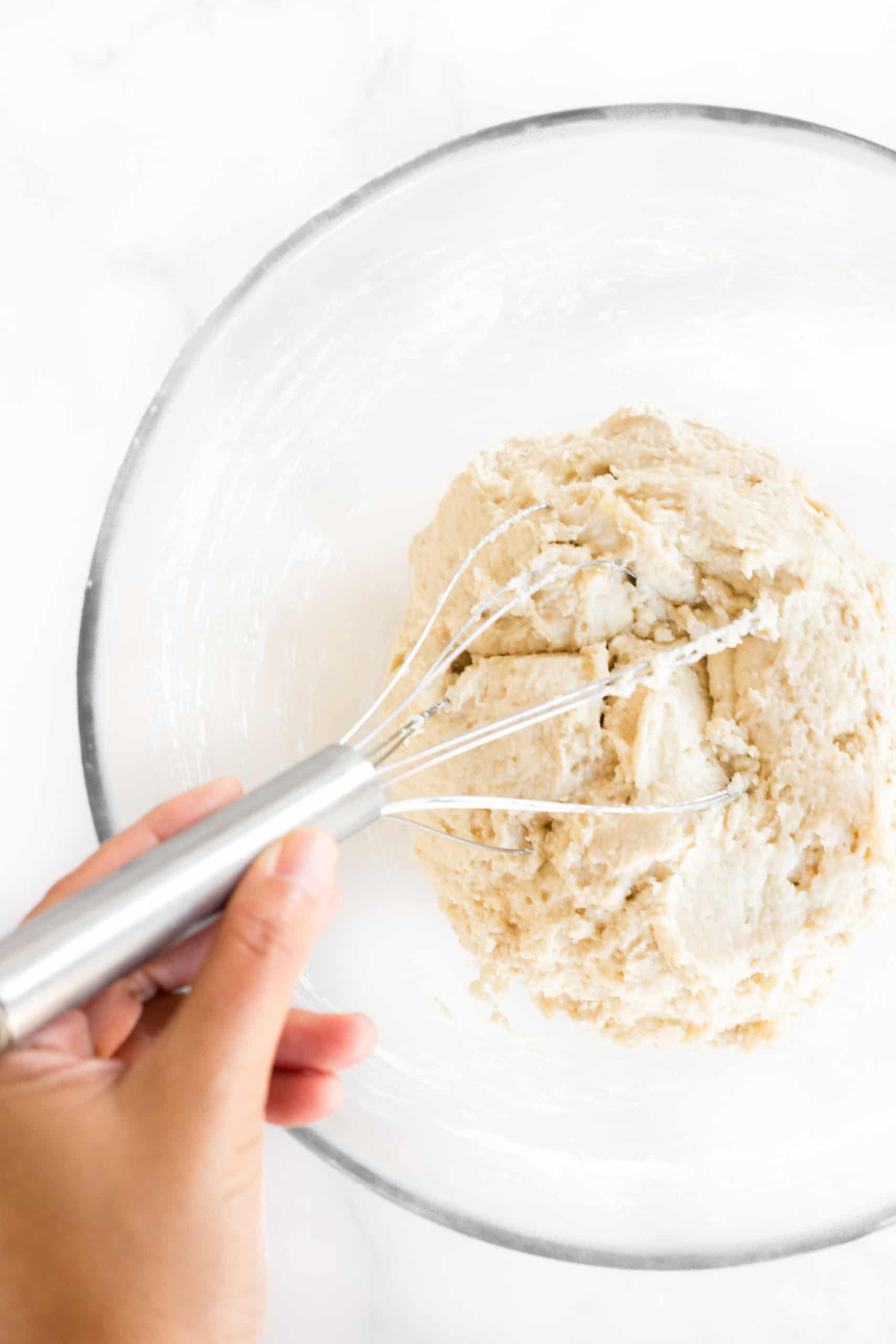
6. Shape Dough
Divide the dough into 4 equal portions and use oiled palms to shape each portion into oblong form, making the ends slightly pointier. Place each shaped dough on the previously lined baking sheet, leaving at least 2 inches between each baguette.
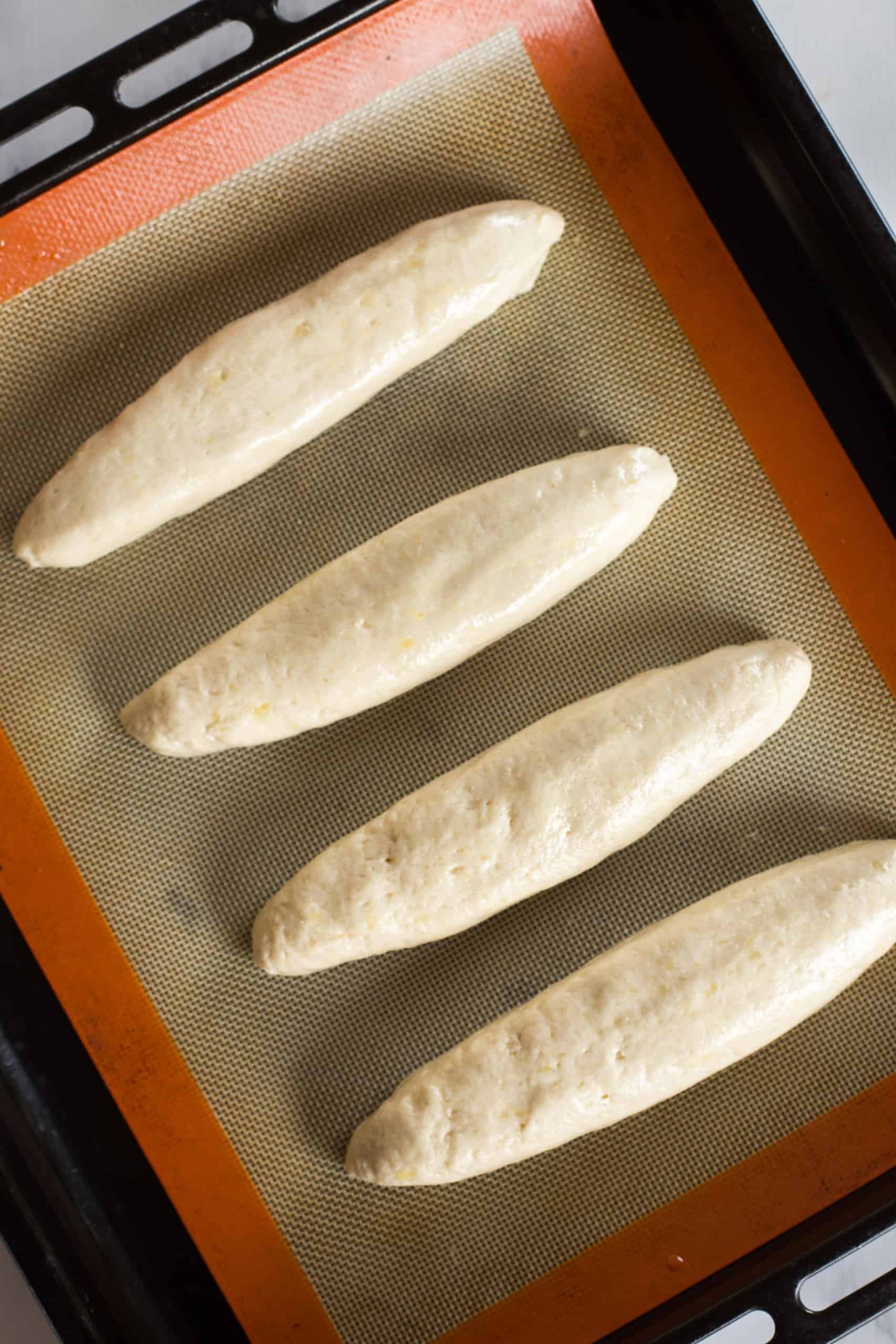
7. Let Rise
Cover the dough with a kitchen towel and let it rise for approximately 1 hour in a warm place free of drafts (the dough will have increased slightly in size, but not exactly double). Once risen, brush with more oil.
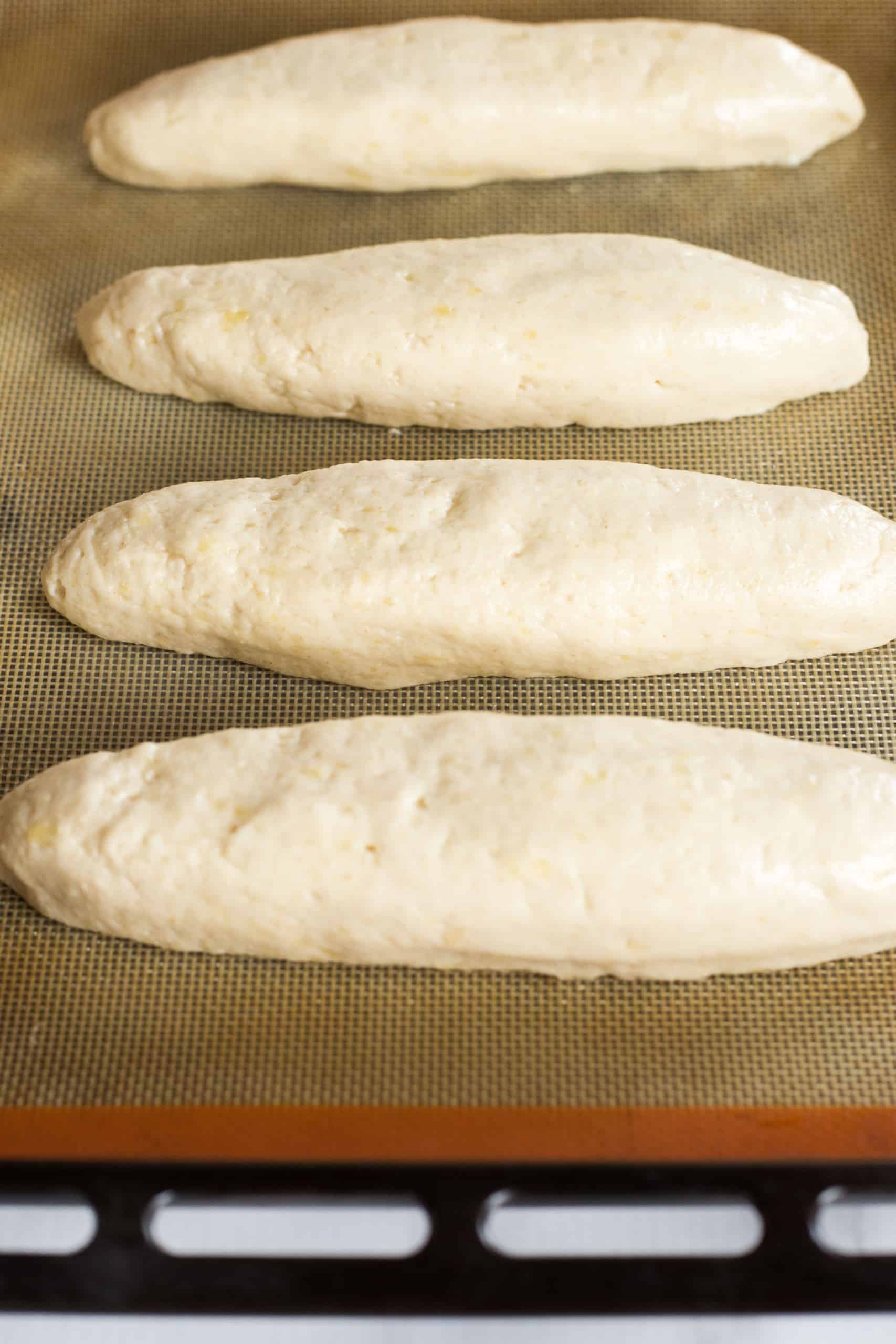
8. Preheat Oven
As the dough is almost to the end of its rise, preheat the oven to 350F (180C) and arrange the oven rack to the middle of the oven.
9. Score Dough
Once the gluten-free baguette dough is done rising, use a smooth-edged knife to score three diagonal lines on top of the dough.
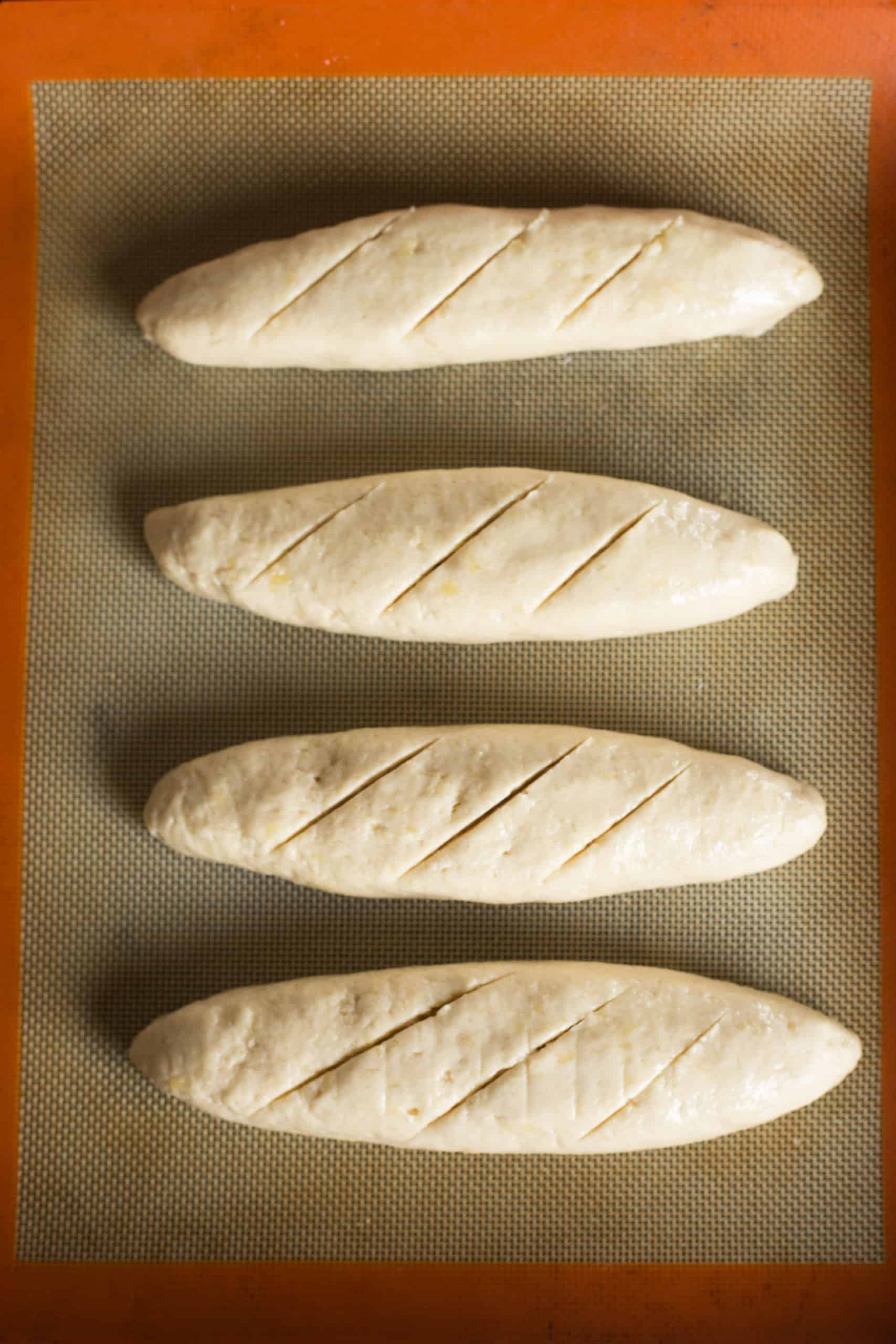
10. Bake Until Golden
Bake the gluten-free baguette dough for 30 to 35 minutes until golden brown on the outside.
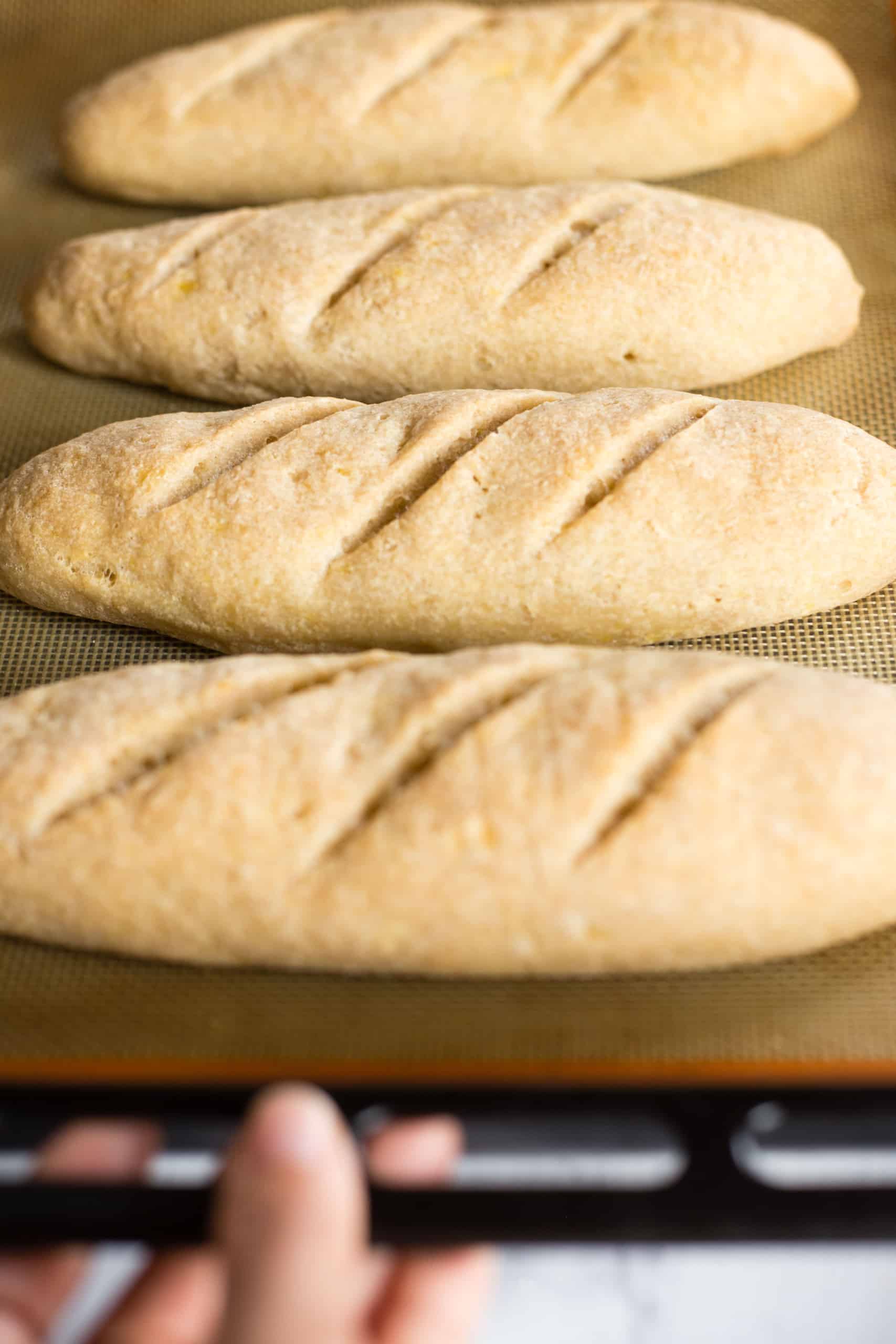
11. Cool Completely
Let the gluten-free baguettes cool completely at room temperature on a wire rack before slicing or serving.
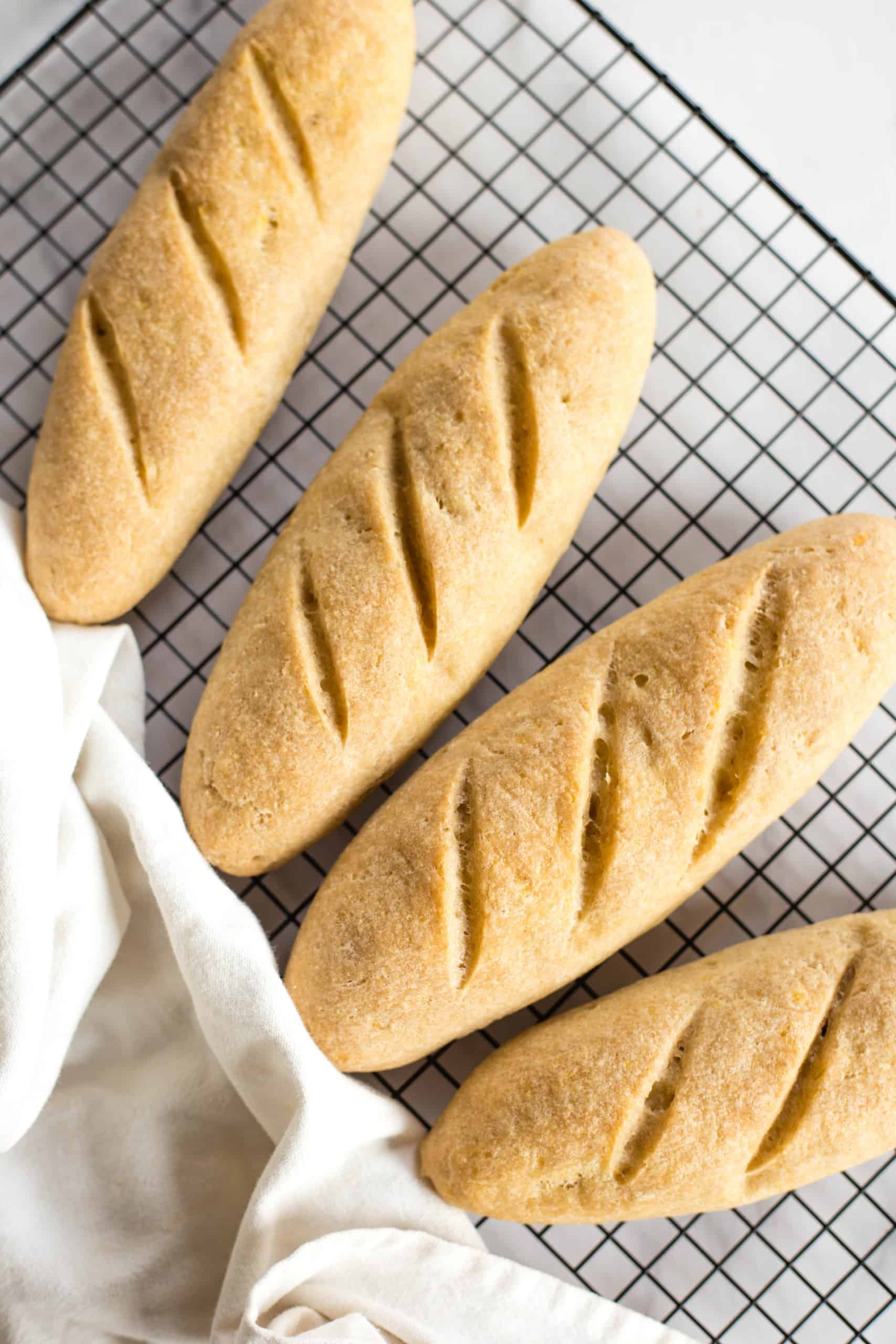
Dish by Dish Tips/Tricks:
- Vary Size of Baguettes: In this case, I divided the dough equally into 4 portions to get 4 baguettes, but you can also divide the dough into 2 portions for longer baguettes or 8 portions for smaller baguettes.
- Use a Baguette Pan: If you’re not keen on molding the dough into a baguette shape yourself, simply transfer the dough into a baguette pan instead.
- Make Bagels: This dough is very flexible, and if you prefer to make bagels instead of baguettes, here’s how to make gluten-free bagels – top them with sesame seeds for a little something extra!
- Make Burger Buns: You can also make burger buns with this dough!
- Add a Little Fiber: If you want to add some extra vegetable fiber to this gluten free French bread dough, simply swap out 1/2 cup of the gluten-free all-purpose flour for a whole grain flour of your choice (such as brown rice flour, sorghum flour, millet flour, or buckwheat flour).
Recipe FAQs:
To store, place the cooled gluten-free baguettes in an airtight container or wrap in plastic wrap and store for up to 3 days in the refrigerator. Reheat slightly before serving.
To freeze, wrap the baguettes in various layers of plastic wrap and freeze for up to 2 months. Let the frozen baguettes thaw completely overnight in the refrigerator, then reheat slightly before slicing or serving.
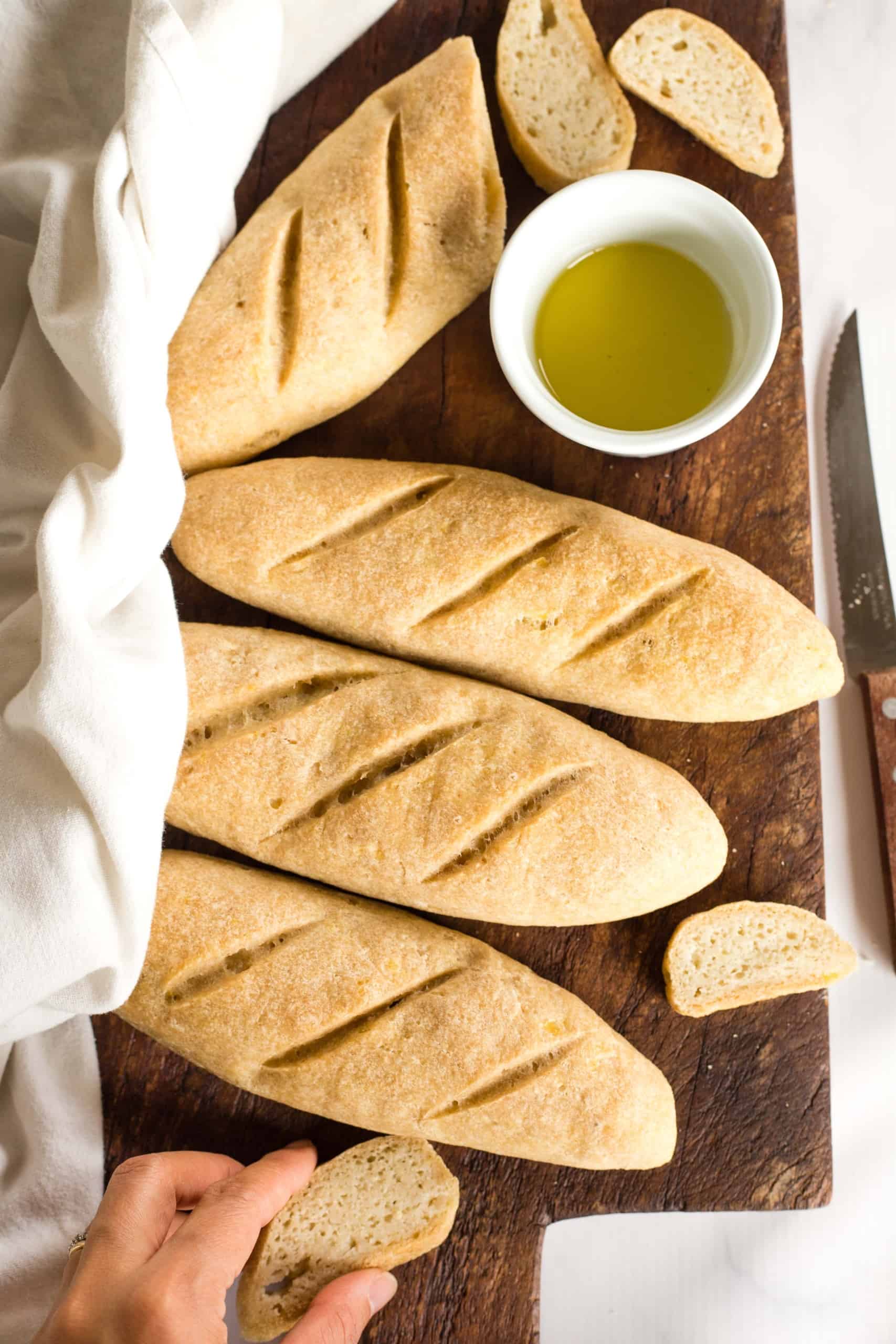
What to Serve with This Gluten-Free Baguette
I highly recommend dipping this gluten-free baguette in some of our favorite soups, such as:
P.S. If you try this recipe, I’d love for you to leave a star rating below, and/or a review in the comment section further down the page. I always appreciate your feedback. Be sure to check out my entire Recipe Index for all the recipes on the blog. You can also follow me on Pinterest, Facebook or Instagram! Sign up for my Email List to get fresh recipes in your inbox each week!
Print
Gluten-Free Baguette Recipe (Dairy-Free)
- Total Time: 1 hour 55 minutes
- Yield: 4 baguettes 1x
- Diet: Gluten Free
Description
Crusty on the outside, and soft and tender inside, this easy gluten-free baguette recipe is perfect for making sandwiches for lunch or dinner, or slicing and toasting to make bruschetta for an appetizer or snack. No kneading required, this recipe is also dairy-free. Bake a batch and enjoy homemade baguettes today!
Ingredients
- 1 cup mashed potatoes
- 2 large eggs, beaten
- 1 cup warm water (between 105F – 115F)
- 1/4 cup sunflower oil + more for brushing
- 2 1/4 cups gluten-free all-purpose flour
- 1 teaspoon xanthan gum (omit if your gluten-free flour blend already includes it)
- 1 teaspoon baking powder
- 1/2 teaspoon salt
- 2 tablespoons psyllium husk powder
- 2 1/4 teaspoons instant yeast
- 1 tablespoon sugar
Instructions
- Line: Line a large baking sheet with parchment paper or a silpat.
- Blend Potatoes and Eggs: Combine mashed potatoes and eggs in the bowl of a blender and blend until you get a smooth pale yellow mixture.
- Add Oil and Water: Transfer the blended potato-egg mixture to a large mixing bowl. Add warm water and oil and mix until you get a homogeneous liquid mixture.
- Whisk Dry Ingredients: In another bowl, sift the gluten-free flour, xanthan gum (if using), baking powder, salt, psyllium husk powder, instant yeast, and sugar. Whisk well to combine.
- Form Dough: Add the dry ingredients to the large bowl with the wet ingredients and mix well until you get a wet and sticky dough (the dough will resemble cake batter and that’s the texture you want).
- Shape Dough: Divide the dough into 4 equal portions and use oiled palms to shape each portion into oblong form, making the ends slightly pointier. Place each shaped dough on the previously lined baking sheet, leaving at least 2 inches between each baguette.
- Let Rise: Cover the dough with a kitchen towel and let it rise for approximately 1 hour in a warm place free of drafts (the dough will have increased slightly in size, but not exactly double).
- Preheat Oven: As the dough is almost to the end of its rise, preheat the oven to 350F (180C).
- Score Dough: Once dough is done rising, use a smooth-edged knife to score three diagonal lines on top of the dough.
- Bake: Bake the gluten-free baguette dough for 30 to 35 minutes until golden brown on the outside.
- Cool Completely: Let the gluten-free baguettes cool completely at room temperature on a wire rack before slicing or serving.
Notes
Mashed Potatoes: For best results, I recommend using fresh mashed potatoes (made from potatoes instead of the mashed potato powder). You can make mashed potatoes by boiling sliced potatoes in water until fork-tender and then mashing the boiled potatoes until they are soft.
Eggs: Eggs help to bind the ingredients better and gives the dough better rise. If you prefer not to use egg yolks, you can replace the two eggs with four egg whites instead. I personally have not made this recipe without eggs, but if you are allergic to eggs, I believe you should be able to replace the eggs with acquafaba or an egg-replacer. (If you do make this gluten-free baguette recipe egg-free, please let me know how it goes in the comments below, I’d love to know!)
Warm Water: Make sure that the water is between 105F to 115F as the warmth is required to activate the yeast, but if the water is too hot, the hight temperature will kill the yeast. You may also use warm unsweetened non-dairy milk instead of water (such as almond milk, cashew milk, rice milk, soy milk or oat milk). Alternatively, if you are not lactose-intolerant, feel free to use normal milk instead.
Sunflower Oil: I like using sunflower oil because I always have a bottle of it on hand. You may also use melted vegan butter or another vegetable oil (such as olive oil, avocado oil, or melted coconut oil). Alternatively, if you are not lactose-intolerant, fee free to use melted butter or ghee instead.
Gluten-Free All-Purpose Flour: I recommend using a good-quality gluten-free all-purpose flour blend that is made up of lighter flours/starches (such as rice flour, tapioca starch, corn starch or potato starch) for a lighter and fluffier final texture. I do NOT recommend using a gluten-free flour blend that includes heavier flours (such as garbanzo bean flour) as that will result in a denser texture.
Xanthan Gum: Xanthan gum is the replacement for gluten in gluten-free flours, so make sure to include it if your gluten-free flour blend does not already have it.
Baking Powder: In addition to the yeast, baking powder gives the dough a little more rise. If you are Celiac or gluten-intolerant, make sure to use certified gluten-free baking powder.
Psyllium Husk Powder: I personally find that the addition of psyllium husk powder makes a big difference in how gluten-free yeast breads turn out, as it adds structure and binding power to the ingredients. Make sure you use the powder version. If you only have access to whole psyllium husks, simply grind the whole husks in a coffee grinder or high-speed blender until you get a very fine powder.
Instant Yeast: I like using instant yeast because there is no prior activation required and you can mix the instant yeast together with the other dry ingredients. If you only have active yeast, make sure to activate the yeast before mixing it with the other ingredients. (To activate, combine the yeast, warm water and sugar in a small bowl and mix well. Let the mixture sit for 5 minutes in a warm place until foamy before adding to other ingredients.)
Sugar: The sugar is “food” for the yeast to feed on in order to be activated and produce the gases required to create the air bubbles for the dough to rise. I used white sugar, but you can also use light brown sugar, dark brown sugar or coconut sugar.
Storing/Freezing: To store, place the cooled gluten-free baguettes in an airtight container or wrap in plastic wrap and store for up to 3 days in the refrigerator. Reheat slightly before serving. To freeze, wrap the baguettes in various layers of plastic wrap and freeze for up to 2 months. Let the frozen baguettes thaw completely overnight in the refrigerator, then reheat slightly before slicing or serving.
- Prep Time: 20 mins
- Rising Time: 1 hour
- Cook Time: 35 mins
- Category: Bread
- Method: Baking
- Cuisine: French

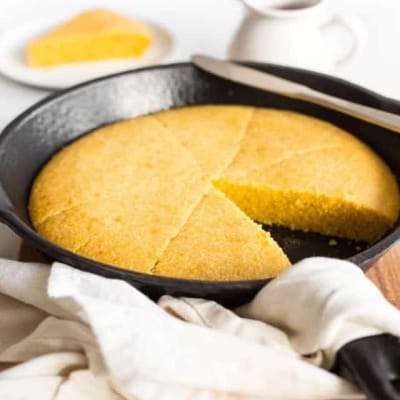
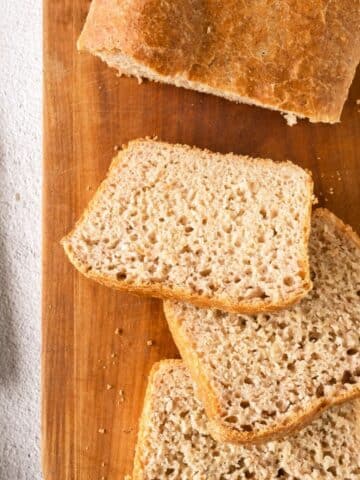
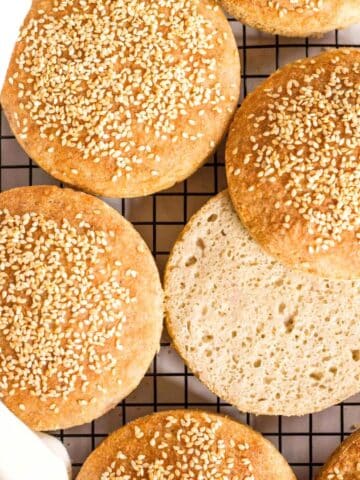

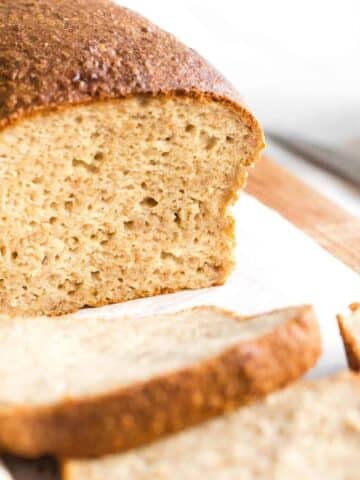

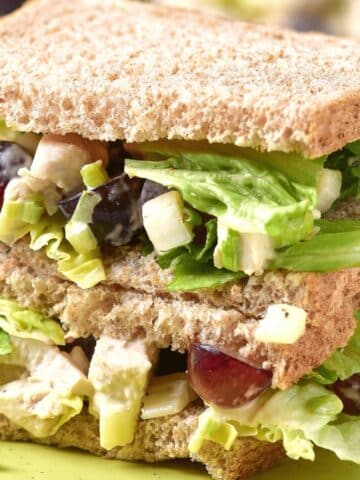




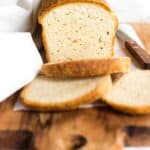





Hi Felicia,
These Baguette are wonderful as I can vary the many ways I eat them – with hot steaming vegetable soups; dip in olive oil; with a rich spread of butter or any other spreads. Toasting them with garlic butter to make garlic bread is just so heavenly to enjoy them !
Yum yum,
Sending you much love and joy as I am now enoying slices of this baguette toasted with garlic and butter,
Mum
Glad you enjoy this baguette mummy!
Love you too